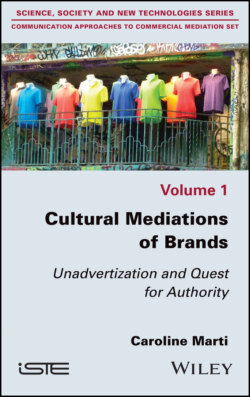Читать книгу Cultural Mediations of Brands - Caroline Marti - Страница 12
I.2.2. Position
ОглавлениеThe first difficulty lies in the complexity of each concept, which have been the subject of approaches by many authors, from various disciplines, over the centuries and decades. This wealth of work can be considered a godsend, but it makes it difficult to deal with concepts. There will therefore be no exhaustive point of view on each notion and their approach will be based on the need to show the links and the preferred perspective.
The perspective will be deliberately communicative, with a strong sensitivity to the semiotic and metamorphic aspects of communication, captured in context, because forms exist only in the socio-techno-economic processes that frame them, captured over time, but also in minds. The forms of communication are in fact the emanation of representations that are sometimes ambivalent, sometimes in confrontation, depending on the groups that generate, value, and mobilize them. The same form can be justified by speeches from very different, even antagonistic perspectives. Finally, this communicational perspective is part of a perspective that values the order of circulation and elaboration to the detriment of an essentialism of forms and representations. This fixing would have its virtues, especially operational, but it is not my objective, my approach being that of deconstruction and objectivity and not that of a particular constructivism for the benefit of an actor or overall an optimization of market activities.
On this subject, my purpose is not to improve the practices of market actors and the examples chosen are not because they are successes or failures; the examples are chosen according to their communicative density, because they seem to me to be emblematic of a particular phenomenon or process.
While the purpose is not to optimize, nor is it to denounce. Therefore, thanks to the comfort of freedom of speech allowed by university research, I will not be prevented from presenting the opportunities, and also the potential threats of practices that can weigh on social forms and collective representations.
While the purpose is not to optimize practices, this will not exclude a certain tribute to the inventiveness and deployment of tactical innovations demonstrated by professionals.
This partitioning of approaches and analytical intentions does not solve the question of the impurity that can be attributed to brand communication. It is central to the subject, insofar as cultural figurations are developed against a background of social reception of brands and, more broadly, of social functioning around brands that are very particular, evolving, variable according to individuals, and often linked to a vision of ambivalent commercial communication. This communication, which can annoy and assault, is often socially disqualified, thought of as impure, self-interested and venal, or even relegated to the oblivion of social value. It is also often praised for its ability to surprise, entertain and seduce.
In any case, it makes it possible to understand the complex and rarely working relationship between brand communication and culture and society.
